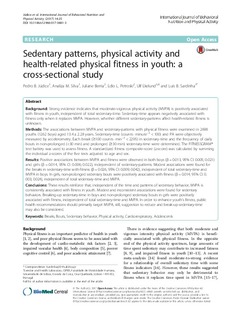| dc.description.abstract | Background: Strong evidence indicates that moderate-vigorous physical activity (MVPA) is positively associated with fitness in youth, independent of total sedentary-time. Sedentary-time appears negatively associated with fitness only when it replaces MVPA. However, whether different sedentary-patterns affect health-related fitness is unknown. Methods: The associations between MVPA and sedentary-patterns with physical fitness were examined in 2698 youths (1262 boys) aged 13.4 ± 2.28 years. Sedentary-time (counts · minute−1 < 100) and PA were objectively measured by accelerometry. Each break (≥100 counts · min−1 < 2295) in sedentary-time and the frequency of daily bouts in non-prolonged (<30 min) and prolonged (≥30 min) sedentary-time were determined. The FITNESSGRAM® test battery was used to assess fitness. A standardized fitness composite-score (z-score) was calculated by summing the individual z-scores of the five tests adjusted to age and sex. Results: Positive associations between MVPA and fitness were observed in both boys (β = 0.013, 95% CI: 0.005; 0.021) and girls (β = 0.014, 95% CI: 0.006; 0.022), independent of sedentary-patterns. Modest associations were found for the breaks in sedentary-time with fitness (β = 0.026, 95% CI: 0.009; 0.042), independent of total sedentary-time and MVPA in boys. In girls, non-prolonged sedentary bouts were positively associated with fitness (β = 0.014, 95% CI: 0.003; 0.024), independent of total sedentary-time and MVPA. Conclusions: These results reinforce that, independent of the time and patterns of sedentary behavior, MVPA is consistently associated with fitness in youth. Modest and inconsistent associations were found for sedentary behaviors. Breaking-up sedentary-time in boys and non-prolonged sedentary bouts in girls were positively associated with fitness, independent of total sedentary-time and MVPA. In order to enhance youth’s fitness, public health recommendations should primarily target MVPA, still, suggestion to reduce and break-up sedentary-time may also be considered. | nb_NO |
